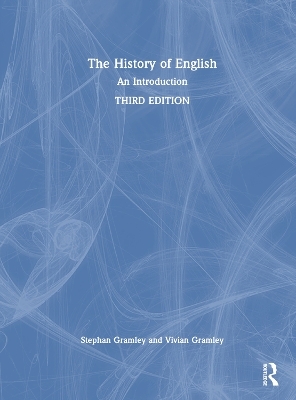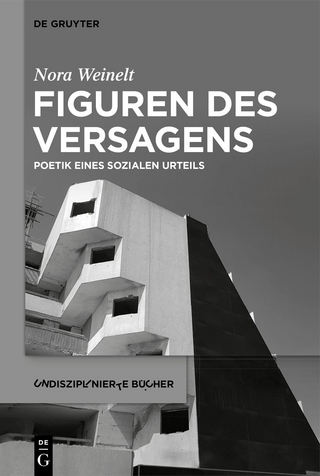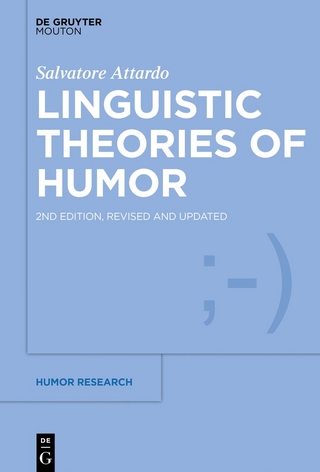
The History of English
Routledge (Verlag)
978-1-032-40970-2 (ISBN)
The History of English: An Introduction provides a chronological analysis of the linguistic, social, and cultural development of the English language from before its establishment in Britain around the year 450 to the present. Each chapter represents a new stage in the evolution of the language, all illustrated with a rich and diverse selection of primary texts. The book also explores the wider global course of the language, including a historical review of English in its pidgin and creole varieties and as a native and/or second language in the Caribbean, Africa, Asia, and Australasia.
The third edition, carefully revised and updated throughout, includes:
● chapter introductions and conclusions to assist in orientation plus additional marginal references throughout;
● the addition of 21 timelines often running from Old English to Present-Day English and focusing on a variety of features;
● a new focus on the relevance of change for and in Present-Day English;
● discussions on the role and image of women, the (in-)visibility of social classes, and regional variation in English;
● material on bilingualism, code-switching, and borrowing, and on the effects of the social media on language use;
● over 90 textual examples demonstrating linguistic change and over 100 figures, tables, and maps, including 31 colour images, to support and illuminate the text;
● updated online support material including brief introductions to Old and to Middle English, further articles on linguistic, historical, and cultural phenomena which go beyond the scope of the book, additional sample texts, exercises, and audio clips.
With study questions as well as recommendations for further reading and topics for further study, The History of English is essential reading for any student of the English language and will be of relevance to any course addressing the origins and development of the English language.
Stephan Gramley is Studiendirektor associated with the Department of Linguistics and Literary Studies at Bielefeld University, Germany, where he has worked in the area of language and cultural studies. He has published books on the English language: A Survey of Modern English with Kurt-Michael Pätzold (1st and 2nd editions) and Vivian Gramley (3rd edition); The Vocabulary of World English, and the Bielefeld Introduction to Applied Linguistics (with Vivian Gramley). Vivian Gramley is a senior lecturer at Bielefeld University, Germany, teaching in applied linguistics, the linguistics of the language system, and language practice. She has published in the areas of clinical linguistics and Deaf education as well as edited the Bielefeld Introduction to Applied Linguistics (with Stephan Gramley), and published the 3rd edition of A Survey of Modern English (with Stephan Gramley and Kurt-Michael Pätzold) and Writing in English Studies (with Katharina Pietsch and Tyll Zybura).
List of Illustrations
List of Plates
List of Figures
List of Maps
List of Timelines
List of Tables
Lists of Texts
Lists of Abbreviations
Preface to the first edition
Preface to the second edition
Preface to the third edition
Acknowledgments
PART I
Before Britain
1 The origins of English (before 450)
Chapter overview
1.1 The origins of human language
1.2 Language change
1.3 Changes in Germanic before the invasions of Britain
1.4 The world of the Germanic peoples
1.5 The Germanic migrations
1.6 Summary
Study questions
Topics of interest for further study
Further reading
PART II
Early English in Britain
2 Old English: early Germanic Britain (450–700)
Chapter overview
2.1 The first peoples
2.2 The Germanic incursions
2.3 Introduction to Old English
2.4 The Christianization of England
2.5 Literature in the early Old English period
2.6 Summary
Study questions
Topics of interest for further study
Further reading
3 Old English: the Viking invasions and their consequences (700–1066/1100)
Chapter overview
3.1 The Viking invasions
3.2 Linguistic influence of Old Norse (ON)
3.3 Creolization
3.4 Standardization
3.5 Social and linguistic variation
3.6 Summary
Study questions
Topics of interest for further study
Further reading
4 Middle English: The non-standard period (1066/1100–1350)
Chapter overview
4.1 Dynastic conflict and the Norman Conquest
4.2 Middle English and question of creolization
4.3 Linguistic features of Middle English in the non-standard period
4.4 English literature
4.5 Dialectal diversity in ME
4.6 Summary
Study questions
Topics of interest for further study
Further reading
5 Middle English: the emergence of Standard English (1350–1500)
Chapter overview
5.1 Political and social turmoil and demographic developments
5.2 The expansion of domains
5.3 Chancery English
5.4 Literature in the late ME period
5.5 Variation in late ME
5.6 Summary
Study questions
Topics of interest for further study
Further reading
6 The Early Modern English Period (1500–1700)
Chapter overview
6.1 The Early Modern English Period
6.2 Early Modern English
6.3 Regulation and codification
6.4 Religious and scientific prose and belles lettres
6.5 Variation
6.6 Summary
Study questions
Topics of interest for further study
Further reading
PART III
Britain and beyond
7 The spread of English (since the late sixteenth century)
Chapter overview
7.1 Social-historical background
7.2 European expansion and the slave trade
7.3 North America
7.4 The Southern Hemisphere
7.5 Second and foreign language countries (ESL and EFL)
7.6 Summary
Study questions
Topics of interest for further study
Further reading
8 Standard and non-standard English
Chapter overview
8.1 Standard English and General English
8.2 English in England, Wales, Scotland – and Ireland
8.3 North American English (NAmE)
8.4 Southern Hemisphere English
8.5 Ethnicity and language
8.6 Summary
Study questions
Topics of interest for further study
Further reading
9 English pidgins, English creoles, and English (since the early seventeenth century)
Chapter overview
9.0 Cultural survivals
9.1 Pidgins
9.2 Creoles
9.3 Pidgin and creole communities
9.4 Theories of origin
9.5 History and textual examples
9.6 Summary
Study questions
Topics of interest for further study
Further reading
10 Grammatical change in ModE
Chapter overview
10.0 Grammatical developments
10.1 Word order
10.2 The noun phrase
10.3 The verb phrase: development of full ModE paradigm
10.4 Other: conjunctions and prepositions
10.5 Substrate influence
10.6 Summary
Study questions
Topics of interest for further study
Further reading
11 Pronunciation change in ModE
Chapter overview
11.1 Introduction and principles of pronunciation change
11.2 The reference accents and other national accents
11.3 Consonants in ModE
11.4 Vowels in ModE
11.5 Vowel changes in ModE: chain shifts and mergers
11.6 Summary
Study questions
Topics of interest for further study
Further reading
12 Vocabulary and Spelling Change in ModE
Chapter overview
12.1 New words and old
12.2 Borrowing
12.3 Word formation
12.4 Pragmatics
12.5 Modern English spelling
12.6 Summary
Study questions
Topics of interest for further study
Further reading
PART IV
13 Worldwide English
Chapter overview
13.1 The beginnings of Global English
13.2 Media dominance
13.3 Features of medialized language
13.4 English in a world-wide context
13.5 Bilingualism, code-switching, and hybrid lasnguages
13.4 Summary
Study questions
Topics of interest for further study
Further reading
Glossary
The International Phonetic Alphabet
General bibliography
Index
| Erscheinungsdatum | 04.06.2024 |
|---|---|
| Zusatzinfo | 64 Tables, black and white; 11 Line drawings, color; 29 Line drawings, black and white; 32 Halftones, color; 31 Halftones, black and white; 43 Illustrations, color; 60 Illustrations, black and white |
| Verlagsort | London |
| Sprache | englisch |
| Maße | 210 x 280 mm |
| Gewicht | 453 g |
| Themenwelt | Geisteswissenschaften ► Sprach- / Literaturwissenschaft ► Anglistik / Amerikanistik |
| Geisteswissenschaften ► Sprach- / Literaturwissenschaft ► Literaturwissenschaft | |
| Geisteswissenschaften ► Sprach- / Literaturwissenschaft ► Sprachwissenschaft | |
| ISBN-10 | 1-032-40970-3 / 1032409703 |
| ISBN-13 | 978-1-032-40970-2 / 9781032409702 |
| Zustand | Neuware |
| Informationen gemäß Produktsicherheitsverordnung (GPSR) | |
| Haben Sie eine Frage zum Produkt? |
aus dem Bereich


